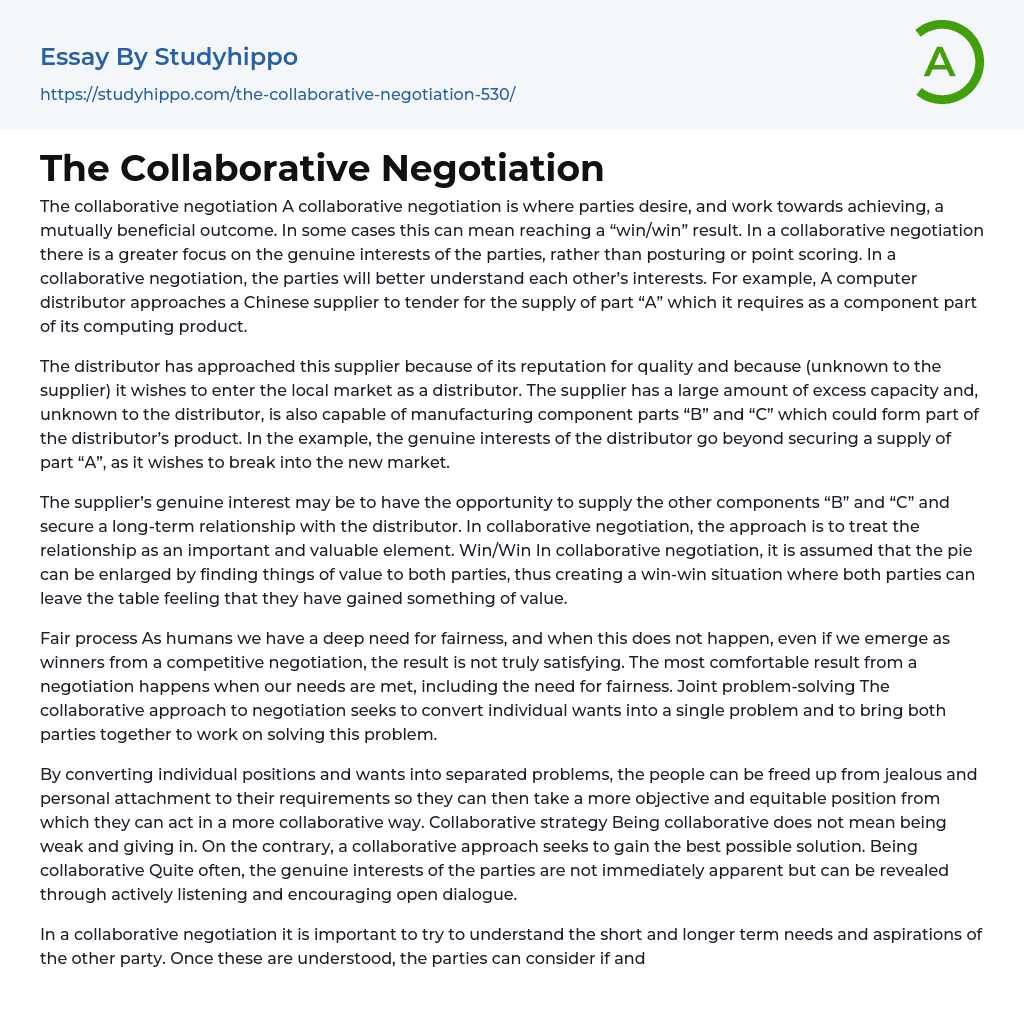In a collaborative negotiation, parties strive to achieve a mutually beneficial outcome, often resulting in a "win/win" result. This type of negotiation emphasizes the genuine interests of the parties rather than posturing or point scoring. It allows the parties to gain a better understanding of each other's interests. For example, a computer distributor reaches out to a Chinese supplier for part "A" as a component of its computing product.
The distributor has contacted this supplier due to its renowned reputation for manufacturing superior products. However, unknown to the supplier, the distributor also has an interest in becoming a local market distributor. It happens that the supplier possesses a substantial amount of unused capacity and can produce component parts "B" and "C," which could potentially be integrated into the distributor's product. In this situation, the distributor's true intentions go
...beyond acquiring part "A." Its objective is to enter and establish a presence in the new market.
The supplier's true intention might be to supply the other components "B" and "C" and establish a long-term relationship with the distributor. Collaborative negotiation emphasizes valuing and prioritizing the relationship. The win/win approach assumes that by discovering mutually valuable aspects, the pie can be expanded, resulting in a situation where both parties benefit and feel they have gained something of value after negotiations.
The desire for fairness is inherent in us as humans. Even if we come out as winners in a competitive negotiation, the lack of fairness leaves us unsatisfied. The most satisfactory outcome from a negotiation occurs when our needs, including the need for fairness, are fulfilled. The collaborative approach to negotiation aims to merge individual desires into one problem and
encourages both parties to join forces in finding a solution.
By transforming individual positions and desires into separate issues, individuals can break free from possessiveness and personal attachment to their needs. This allows them to adopt a more objective and fair stance, enabling them to engage in a more cooperative manner. Collaborative strategy does not imply weakness or surrender; instead, it aims to achieve the optimal solution. Often, the true interests of the parties involved may not be immediately evident, but active listening and promoting open dialogue can uncover them.
When engaging in a collaborative negotiation, it is essential to comprehend the other party's short and long-term needs and aspirations. By doing so, both sides can assess whether their true interests align and explore innovative methods to achieve a mutually advantageous outcome. There are various approaches to fostering collaboration during a negotiation, such as relationship building. For a collaborative negotiation to thrive, a favorable rapport, accompanied by mutual trust and respect, must be established.
Investing time in building relationships and setting a positive tone is crucial. This can involve friendly preliminaries and establishing legitimacy in discussions. Encouraging openness, while cautioning against inappropriate information sharing, can foster trust and collaboration. Additionally, actively listening helps identify common ground.
Finding common ground and understanding the concerns of the other party are crucial steps in proposing a solution. Taking a long-term perspective helps put problems into perspective and ensures lasting agreements. Being creative in problem-solving increases the chances of avoiding deadlock. Rather than seeing a problem as insurmountable, it is important to find areas where value can be created and opportunities for concessions and advantages. Showing empathy and understanding can be persuasive in
establishing the reasonableness of your requirements.
By approaching the situation from their perspective and establishing a connection to a shared goal, you can create a bridge that satisfies both parties. This method demonstrates that you have taken their concerns into account and are genuinely working towards a resolution that is mutually beneficial (Wilmot ; Hocker, 2010). For more information on collaborative negotiation styles, please visit: http://changingminds.org/disciplines/negotiation/styles/collaborative_negotiation.htm and http://www.insights.org.uk/articleitem.aspx?title=Common%20Themes%20in%20Commercial%20Negotiations.
- Business Analysis essays
- Business Plan essays
- Community Development essays
- Competition essays
- Effective Leadership essays
- Leadership Styles essays
- Mission Statement essays
- Negotiation essays
- Outsourcing essays
- Planning essays
- Public relations essays
- Reasoning essays
- Strategic Management essays
- Strategic Planning essays
- Swot Analysis essays
- Consciousness essays
- Intelligence essays
- Mindset essays
- Perception essays
- Problem Solving essays
- Resilience essays
- Abnormal Psychology essays
- Abraham Maslow essays
- Attachment Theory essays
- Authority essays
- Behaviorism essays
- Classical Conditioning essays
- Cognitive Psychology essays
- Counseling essays
- Developmental Psychology essays
- Educational Psychology essays
- Erik Erikson essays
- Family Therapy essays
- Jean Piaget essays
- Maslow's Hierarchy Of Needs essays
- Mental Health essays
- Operant Conditioning essays
- Personality Psychology essays
- Positive Psychology essays
- Psychoanalysis essays
- Psychotherapy essays
- Sigmund Freud essays
- Social Psychology essays
- Stanford Prison Experiment essays
- Supersize Me essays




